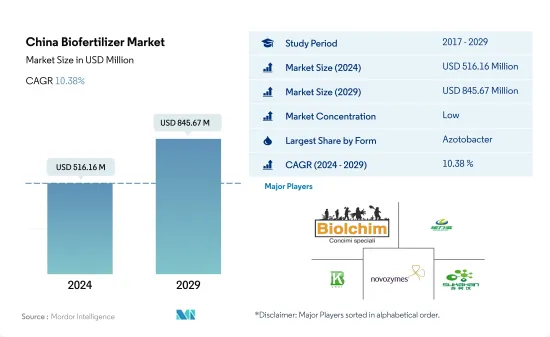Need help finding what you are looking for?
Contact Us
PUBLISHER: Mordor Intelligence | PRODUCT CODE: 1433769

PUBLISHER: Mordor Intelligence | PRODUCT CODE: 1433769
China Biofertilizer - Market Share Analysis, Industry Trends & Statistics, Growth Forecasts (2024 - 2029)
PUBLISHED:
PAGES: 136 Pages
DELIVERY TIME: 2-3 business days
SELECT AN OPTION
The China Biofertilizer Market size is estimated at USD 516.16 million in 2024, and is expected to reach USD 845.67 million by 2029, growing at a CAGR of 10.38% during the forecast period (2024-2029).

Key Highlights
- Azotobacter is the Largest Form : Azotobacter is a nitrogen-fixing bacteria that capable of fixing roughly 20.0 kg of nitrogen per hectare and can be used as a substitute for mineral nitrogen fertilizers.
- Rhizobium is the Fastest-growing Form : Rhizobium, a member of the bacterial family Rhizobiaceae, can fix N2 in both legumes and non-legume crops and capable of fixing up to 300 kg N/ha/year in various legume crops.
- Row Crops is the Largest Crop Type : The major row crops grown in China are rice, wheat, corn, peanuts, millet, barley, oilseeds. Azotobacter is the most consumed biofertilizer in row crops with 31.7% in 2022.
- Cash Crops is the Fastest-growing Crop Type : The major cash crops grown in China include sugarcane, tea, cotton, tobacco, etc. Seaweed extracts are the most consumed biofertilizer in cash crops with 29.6% in 2022.
China Biofertilizer Market Trends
Azotobacter is the largest Form
- Biofertilizers are living microorganisms that improve plant nutrition by mobilizing or increasing nutrient availability in soils. Biofertilizers are essential components of organic farming that play an important role in long-term soil fertility and sustainability by fixing atmospheric nitrogen, mobilizing fixed macro and micronutrients, or converting insoluble phosphorous in the soil into forms available to plants.
- In the Chinese biofertilizer market, Azotobacter is the most consumed biofertilizer, dominating the market with a share of 31.3%, valued at USD 137.1 million, followed by Mycorrhiza, Azospirillum, Rhizobium, and phosphate-solubilizing bacteria with shares of 22%, 22.0%, 11.6%, and 11.2%, respectively, in 2022.
- As of 2021, China achieved its "eighteenth consecutive bumper grain harvest." However, this achievement was accomplished by problems such as the chronic overuse of agricultural fertilizers. China exceeds the internationally accepted upper limit of agricultural fertilizer per unit area. As a major global agricultural producer, China proposed a fertilizer reduction and efficiency initiative in 2015 to achieve "zero fertilizer growth rate and zero fertilizer use reduction" by 2020. China achieved a fertilizer reduction of 12.82% from 2015 to 2020. This initiative increased the consumption value of biofertilizers in the Chinese agricultural sector by 7.0% during the historical period (2017-2022).
- Organic farming is also increasing in China as the demand for organic food continues to rise. From 2017 to 2022, 29.6% of organic acreage increased. Increasing organic acreage and government initiatives are expected to boost the value of the Chinese biofertilizers market during the forecast period by 78.8%.
China Biofertilizer Industry Overview
The China Biofertilizer Market is fragmented, with the top five companies occupying 3.08%. The major players in this market are Biolchim SpA, Genliduo Bio-tech Corporation Ltd, Kiwa Bio-Tech, Novozymes and Shandong Sukahan Bio-Technology Co. Ltd (sorted alphabetically).
Additional Benefits:
- The market estimate (ME) sheet in Excel format
- 3 months of analyst support
Product Code: 64594
TABLE OF CONTENTS
1 EXECUTIVE SUMMARY & KEY FINDINGS
2 REPORT OFFERS
3 INTRODUCTION
- 3.1 Study Assumptions & Market Definition
- 3.2 Scope of the Study
- 3.3 Research Methodology
4 KEY INDUSTRY TRENDS
- 4.1 Area Under Organic Cultivation
- 4.2 Per Capita Spending On Organic Products
- 4.3 Regulatory Framework
- 4.4 Value Chain & Distribution Channel Analysis
5 MARKET SEGMENTATION
- 5.1 Form
- 5.1.1 Azospirillum
- 5.1.2 Azotobacter
- 5.1.3 Mycorrhiza
- 5.1.4 Phosphate Solubilizing Bacteria
- 5.1.5 Rhizobium
- 5.1.6 Other Biofertilizers
- 5.2 Crop Type
- 5.2.1 Cash Crops
- 5.2.2 Horticultural Crops
- 5.2.3 Row Crops
6 COMPETITIVE LANDSCAPE
- 6.1 Key Strategic Moves
- 6.2 Market Share Analysis
- 6.3 Company Landscape
- 6.4 Company Profiles
- 6.4.1 Atlantica Agricola
- 6.4.2 Binzhou Jingyang Biological Fertilizer Co. Ltd
- 6.4.3 Biolchim SpA
- 6.4.4 Dora Agri-Tech
- 6.4.5 Genliduo Bio-tech Corporation Ltd
- 6.4.6 Kiwa Bio-Tech
- 6.4.7 Novozymes
- 6.4.8 Shandong Sukahan Bio-Technology Co. Ltd
- 6.4.9 Sustane Natural Fertilizer Inc.
- 6.4.10 Symborg Inc.
7 KEY STRATEGIC QUESTIONS FOR AGRICULTURAL BIOLOGICALS CEOS
8 APPENDIX
- 8.1 Global Overview
- 8.1.1 Overview
- 8.1.2 Porter's Five Forces Framework
- 8.1.3 Global Value Chain Analysis
- 8.1.4 Market Dynamics (DROs)
- 8.2 Sources & References
- 8.3 List of Tables & Figures
- 8.4 Primary Insights
- 8.5 Data Pack
- 8.6 Glossary of Terms
Have a question?


SELECT AN OPTION
Have a question?


Questions? Please give us a call or visit the contact form.
